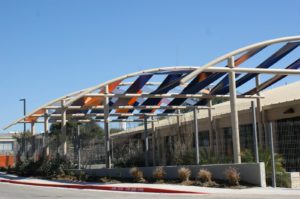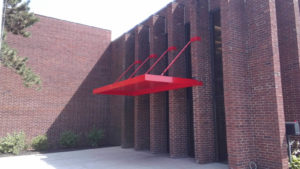
If you have ever had to source sustainable materials for a building design, you know about rating systems like Leadership in Energy and Environmental Design (LEED), administered by the nonprofit U.S. Green Building Council, (USGBC). The LEED systems consider the amount of energy used to manufacture the building material and the carbon footprint it leaves in transporting it to the construction site. There are many more calculations that are made in determining a LEED rating, or Cradle-to-Cradle ranking, but the metrics of manufacturing and transport are big with all construction materials.
Given these two facts, fabric has an immediate advantage that many construction materials can’t match, because fabric—pound for pound—can cover far greater areas with significantly less actual mass (less material per square foot) than any other material. This multiplies the advantage of fabric over traditional materials like wood, glass and metal at every step in factory-to-finish construction; the factors include the manufacturing process, transportation, replacement costs and energy metrics in recycling for reuse.
Other sustainable factors can help tip the balance, such as the fact that most architectural fabrics are recyclable, an advantage that can make the difference when you tally up the numbers. Some manufacturers make a promotional point that their fabrics are 100 percent recyclable.
To help you with this calculation, several Professional Awning Manufacturers Association (PAMA) firms weighed in on how they assess these advantages across the board. Keep in mind that not every project should use fabric, when a traditional material may make more sense, such as with historic restoration or historic district overlays. Nevertheless, what the following experts suggest could help your decision process.

Consider the project first
In closing a project deal with a potential customer, there are prime arguments or selling points for the use of fabric. However, all of our experts say the type of project needs to be carefully considered. “It really depends on who the customer is,” says Gary Barnes, president of Tropical J’s Inc., Honolulu, Hawaii. “Is it an architect who is focused on design, a contractor who is focused on price and schedule, or the owner who is focused on use and price? Let’s focus on the architect: We architects push design that excites, complements and enhances a client’s vision for the building. Often architects have directions and price and permitting limitations from the owners and contractors. Our goal [as fabricators] then is to work with them to solve pricing and permitting limitations while still keeping to their vision.”
“My approach to selling is to not sell,” says Tim Kellogg, of Capital City Awning, Columbus, Ohio. “In my point of view, I’m trying to help someone solve a problem or achieve their vision of how they want their business to be perceived. Frankly, if someone wanted protection over their entrance and they wanted to create an industrial image or rural-agricultural (corrugated) image, or if they just wanted a flat slab that provided protection with very little visual intrusion, then I might suggest a metal canopy, provided they had a budget that would allow it.”

Advantages of fabric
“First, there are so many different color selections and fabric types with fabric awnings,” says Barry Adams, president of Peachtree Awnings, Norcross, Ga. “With metal you are limited to about 40 different colors. With fabric awnings, you likely have over 200 different colors to select from. Secondly, the fabric awning gives you flexibility that you cannot achieve with a metal awning or canopy. If a tenant moves out, the awning can be changed out at minimal cost by recovering the awning. This is virtually impossible with a metal canopy.”
Capital City Awning’s Kellogg agrees. Kellogg says, “A fabric awning provides a totally different image for a business entrance than a metal awning, and, depending upon the reason for choosing an awning, a fabric awning can be a much better choice. For example, we provide fabric awnings to many different clothing retailers. They choose fabric because they sell fabric. Their customers are usually women. Fabric awnings seem softer and more feminine than metal awnings. We also sell fabric awnings to businesses that want to attract attention with bright clever colors.
“Metal awnings often are more utilitarian and are not attention seekers,” notes Kellogg. “We sell fabric awnings to businesses that wish to add a company logo or graphics to the awning, again, attention seeking. We sometimes even digitally print a very unique pattern on fabric awnings. This is usually not done with metal awnings. In short, fabric awnings are far more versatile than metal and offer many visual benefits that metal awnings cannot provide.”
“No matter the setting —home, retail, hospitality— fabrics, with their softer textures, sophisticated color pallets and patterns, project a taste and style that conveys a more welcoming impression,” says Roy Chism, of The Chism Co., San Antonio, Texas. “This lends itself to an organic environment not achievable with the hard lines and design limitations associated with metal.”
For Tropical J’s, Barnes says that “First and foremost, design” should be the prime factor. “We consider awnings to be the ‘bow and ribbon’ the contractor puts on the gift they present to the owner at the end of a project. You’re essentially limited to one design for metal awnings, the standard sloped configuration; on rare occasions there might be a barrel, but that’s a very expensive option. Fabric awnings can take almost any shape you can dream up.”
Barnes adds, “Restaurants and hotels tend to change out awning colors on a regular basis during remodels. Changing out the fabric on an awning is an easy and cheap way to make a big splash.”
“Today’s advanced and technical fabrics combined with a well-equipped ‘state-of-the-industry’ end product fabrication facility, delivers a less expensive, faster, better value of shading solutions and aesthetic applications than metal alternatives —commercial or residential,” says Chism.

Other considerations
“Fabric awnings tend to reflect the character of what’s inside,” says Barnes. “Metal awnings tend to look industrial and unsuitable for many buildings, particularly shops and restaurants looking for elegance. Also, [metal] standing seam is an expensive way to add area when thinking of a canopy. Fabric structures are normally less expensive.” And when it comes to keeping continuity between a project’s various shading elements, it is relatively easy to do this between canopies and awnings, according to Barnes. “Adding fabric canopies is a relatively inexpensive way to add revenue area.”
“At the close of any project discussions,” says Chism, “there’s never an argument as to the material choice.
If the trade has done its job well, the customer/specifier has already made a decision defining the general materials selection as fabric.”
“Fabrics typically have a 5–10-year warranty and the price is roughly 30–40 percent less than its metal counterpart,” says Adams. “When you add up the factors—flexibility, cost and longevity—the fabric awning is still the best value.”

“I never like to lead with my price card,” say Kellogg, “but let’s face it, fabric awnings are far less expensive in the short term. And, it seems, most of our customers really only care about the short term.”
Bruce N. Wright, AIA, the former editor of Fabric Architecture, is a consultant to architects and designers, and a frequent contributor to Fabric Architecture, Specialty Fabrics Review and Advanced Textiles Source.
 TEXTILES.ORG
TEXTILES.ORG


